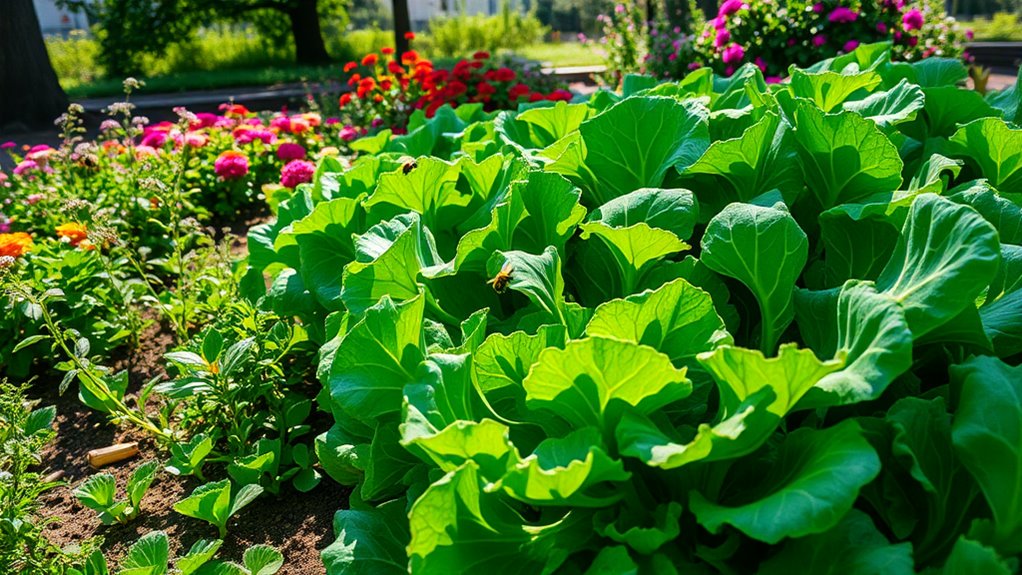What Plants Thrive Together. Try These 5 Combos
If you’re looking to maximize your garden’s potential, try these five plant combos. Pair tomatoes with basil to boost flavor and repel pests. Combine carrots and onions to deter carrot flies and promote healthy growth. Use beans alongside corn for nitrogen fixation and structural support. Marigolds can enhance pepper growth while keeping pests at bay. Finally, radishes can help cucumbers thrive by improving soil aeration. Explore these partnerships for a flourishing garden ecosystem!
Tomatoes and Basil
When you plant tomatoes and basil together, you’re not just creating a flavorful garden; you’re also enhancing the health and productivity of both plants.
This combination is a classic example of companion success.
Basil naturally repels pests like aphids and whiteflies that often plague tomatoes.
Additionally, the aromatic compounds in basil can improve the flavor profile of tomatoes. This pairing can also enhance growth and pest resistance, making it a beneficial strategy for gardeners.
Make sure you provide ample sunlight, well-draining soil, and consistent watering for ideal growth.
Carrots and Onions
Carrots and onions make an excellent duo in the garden, as their growth habits complement each other remarkably well.
Carrots thrive in loose, well-drained soil, while onions prefer similar conditions, allowing both to flourish without competing for nutrients.
Planting them together can deter pests; the strong scent of onions masks the aroma of carrots, confusing carrot flies.
Be sure to space them adequately to prevent overcrowding, ensuring both plants receive sufficient light and nutrients.
Water them regularly, keeping the soil moist but not soggy, and watch as they grow harmoniously, enhancing your garden’s productivity and flavor. Additionally, this combination exemplifies companion planting principles, which can lead to improved yields and reduced pest issues in your garden.
Beans and Corn
The dynamic pairing of beans and corn creates a symbiotic relationship that benefits both crops in the garden. Beans fix nitrogen in the soil, enriching it for corn, while corn provides a natural support structure for climbing bean varieties. This combination maximizes space and resources, promoting healthy growth. Additionally, this method of planting is a great example of companion planting, which can enhance biodiversity and improve crop resilience.
| Benefits | Beans | Corn |
|---|---|---|
| Nutrient Fixation | Fix nitrogen | Utilizes nitrogen |
| Support | Climbs on corn stalks | Provides height |
| Growth Rate | Quick growth | Steady growth |
Planting these together not only enhances yield but also fosters a thriving ecosystem.
Peppers and Marigolds
Peppers and marigolds make an excellent duo in the garden, providing both aesthetic appeal and practical benefits.
When you plant them together, you’ll notice:
- Pest Control: Marigolds emit a scent that repels aphids, nematodes, and other pests, protecting your peppers.
- Soil Health: Their roots release compounds that improve soil quality, promoting healthier pepper growth.
- Pollinator Attraction: Marigolds attract beneficial insects, enhancing pollination for your pepper plants. Additionally, this effective companion planting strategy can lead to even greater yields and overall garden productivity.
Cucumbers and Radishes
Cucumbers and radishes complement each other remarkably well in the garden, combining fast growth with beneficial interactions. Radishes help break up the soil, making it easier for cucumber roots to spread. Additionally, they mature quickly, allowing you to harvest before cucumbers need the space. This pairing is a great example of perfect plant pairs that can enhance growth and health in your garden.
| Plant | Benefits |
|---|---|
| Cucumbers | Provide shade for radishes |
| Radishes | Improve soil aeration |
| Growth Rate | Radishes mature in 30 days |
Planting these two together not only maximizes space but also promotes healthier crops, creating a thriving garden ecosystem.





